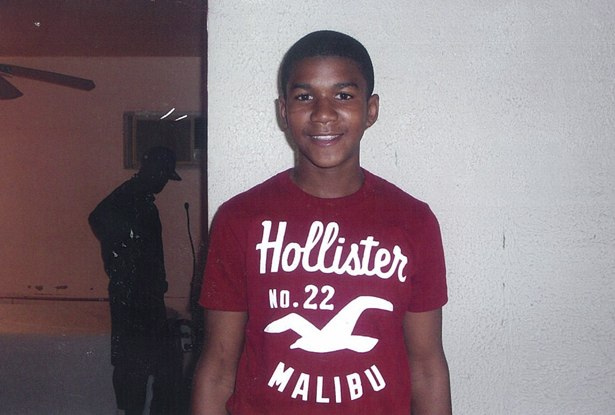
Trayvon Martin, a black teenager who was fatally shot by a neighborhood watch volunteer. (AP Photo/HO, Martin Family Photos.)
On the face of it, the fates that befell 22-year-old Rodrigo Diaz and 7-year-old Wilson Reyes may seem unrelated. A Bronx elementary school student, Reyes was handcuffed and, according to his family, interrogated by police for up to ten hours, because of a playground scuffle over five dollars. Diaz, meanwhile, was shot and killed when he mistakenly pulled into the driveway of Phillip Sailors, a 69-year-old Vietnam veteran, in Lilburn, Georgia.
But they’re connected. Let me explain how. David E. Diaz-Valencia, Diaz’s brother, told NBC Latino, “We don’t think it’s about racism. Maybe the guy was angry, trying to protect his own property.” Sailors’s attorney, Michael Puglise, told the Atlanta Journal-Constitution this was “not a question of color, not a question of race, this is a question of a tragic event dictated by fear.” But fear of whom? With due respect to Diaz-Valencia’s optimism, I find it almost impossible for to think up a scenario in which a car full of white youth pulls into the wrong driveway, the owner of the home fires a warning shot before confronting them, as Sailors did, and then the driver of the vehicle is shot in the head as he’s backing the car out and attempting to apologize, as was the case with Diaz. Because in our American imagination, the only time a group of young white people pose a threat that requires a violent response is when they’re occupying Wall Street. The victims in these cases of “mistaken” identity always come up as people of color.
And maybe Sailors would have done the same if they were white. He may have just been that angry at any trespasser. There isn’t really a way for us to be sure. What we do know that happened is a group of young Latinos pulled into the wrong driveway, and a man shot one of them because he was afraid they might be gang members trying to rob him. Now I ask, how does that man come to such a conclusion so quickly?
Popular
"swipe left below to view more authors"Swipe →
Well, it starts with putting a 7-year-old brown kid in handcuffs over five dollars he didn’t steal. Perhaps it’s still a foreign concept to most people, but the criminalization of black and brown youth is a daily routine. Reyes’s situation isn’t unlike that of 6-year-old Salecia Johnson, who in April of last year was arrested and handcuffed in school, after what was described as “temper tantrum.” Before her, there was 5-year-old Michael Davis, whose hands and feet with restrained with zip ties when his school called the police in to scare away his behavioral problems. The kids get the message a very young age, and the rest the world does as well, that they are potential menaces to society and will be treated as such.
That’s why, in the Washington, DC, area, black kids are two to five times more likely to suspended or expelled from school than their white classmates, and why in New York City, over the course of a four-month period in the summer and fall of 2011, all but four of the sixty-three students arrested in school were black or Latino. They aren’t disproportionately more disruptive, but their behavior is interpreted as such.
This is how you end up with Trayvon Martins and Jordan Davises. We create these images of monsters and then wonder why people go out slaying them.
This is part of the reason why the current gun control debate is so disingenuous. We want universal background checks to ensure criminals don’t have access to guns, but then don’t look at the ways in which we create criminals. We want mental health checks, but show little-to-no concern for the trauma visited upon black and brown youths caught in the crosshairs of violence and racism. But none of this is surprising.
Which is perhaps the most infuriating aspect of it all. I wasn’t shocked when I read about Diaz, though I wanted to be. I’ve come to expect news like this to hit me in the face before I’ve even had breakfast. Too many of us have, and we know that it will continue to be that way as long as our fellow citizens continue to see young people of color as little more than a bunch of thugs in waiting.
Barack Obama is leading a campaign against mass shootings, but what about the masses killed by gun violence every year in inner cities? Mychal Denzel Smith calls for fewer guns for everyone.


